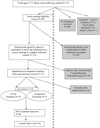The Child and Family Traumatic Stress Intervention: secondary prevention for youth at risk of developing PTSD
- PMID: 20868370
- PMCID: PMC3096712
- DOI: 10.1111/j.1469-7610.2010.02321.x
The Child and Family Traumatic Stress Intervention: secondary prevention for youth at risk of developing PTSD
Abstract
Objective: This pilot study evaluated the effectiveness of a four-session, caregiver-child Intervention, the Child and Family Traumatic Stress Intervention (CFTSI), to prevent the development of chronic posttraumatic stress disorder (PTSD) provided within 30 days of exposure to a potentially traumatic event (PTE).
Method: One-hundred seventy-six 7 to 17-year-old youth were recruited through telephone screening based on report of one new distressing posttraumatic stress symptom after a PTE. Of those, 106 youth were randomly assigned to the Intervention (n = 53) or a four-session supportive Comparison condition (N = 53). Group differences in symptom severity were assessed using repeated measures with mixed effects models of intervention group, time, and the interaction of intervention and time. Logistic regression analyses were performed to assess treatment condition and any subsequent traumas experienced as predictors for full and partial PTSD diagnosis at 3-month follow-up. An exploratory chi-square analysis was performed to examine the differences in PTSD symptom criteria B, C, and D at follow-up.
Results: At baseline, youth in both groups had similar demographics, past trauma exposures and symptom severity. At follow-up, the Intervention group demonstrated significantly fewer full and partial PTSD diagnoses than the Comparison group on a standardized diagnostic measure of PTSD. Also, there was a significant group by time interaction for Trauma Symptom Checklist for Children's Posttraumatic Stress and Anxiety Indices as the CFTSI group had significantly lower posttraumatic and anxiety scores than the Comparison group.
Conclusions: The results suggest that a caregiver-youth, brief preventative early intervention for youth exposed to a PTE is a promising approach to preventing chronic PTSD.
© 2010 The Authors. Journal of Child Psychology and Psychiatry. © 2010 Association for Child and Adolescent Mental Health.
Figures
References
-
- Achenbach TM, Rescorla LA. Manual for the ASEBA school-age forms and profiles. Burlington, VT: University of Vermont, Research Center for Children, Youth, and Families; 2001.
-
- Allison P. Multiple Imputation for Missing Data: A Cautionary Tale. Sociological Methods and Research. 2000;28:301–309.
-
- Angold A, Costello EJ. Mood and Feelings Questionnaire (MFQ) 1987
-
- Berkowitz S, Stover CS. Trauma history questionnaire parent and child version. Yale Child Study Center Trauma Section; 2005. Unpublished questionnaire.
-
- Blake DD, Weathers FW, Nagy LM, Kaloupek DG, Gusman FD, Charney DS, et al. The development of a clinician-administered PTSD scale. Journal of Traumatic Stress. 1995;8(1):75–90. - PubMed
Publication types
MeSH terms
Grants and funding
LinkOut - more resources
Full Text Sources
Medical
Miscellaneous



